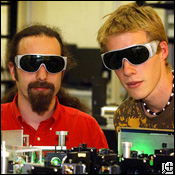May 10, 2004 — Teleportation always used to seem so simple. All it took was a quick call to Mr. Scott, and Star Trek's Captain Kirk would be beamed up from the cheap-looking scenery of some alien planet and materialize on the Starship Enterprise.
These days it's all about lasers, subatomic particles and quantum physics, say Australian and Canadian researchers, who have teleported information to more than one place.
They predicted their research would bring unbreakable codes and super-fast computers a step closer.
|
|
|||||||
The Australian National University (ANU) and University of Calgary researchers published their work in a recent issue of the journal Physical Review Letters.
Ping Koy Lam and his team securely teleported a signal to a network of recipients that only a majority could reassemble. Any fewer and the signal could not be reconstructed.
Earlier work at ANU had achieved teleportation. But Ping described the latest work as "a much more complex form of information teleportation in the sense that it involves multiple recipients."
Teleportation is the production, disembodiment and successful reconstruction of a signal. In this case the signal was a high frequency sound to three participants. In the future, the message may be spoken or typed.
The researchers used crystals, lenses, mirrors and lasers to produce a pair of "entangled" particles that can affect each other from afar. These particles are then used to carry fragile information in the form of quantum states.
"These quantum states cannot be measured or copied, making eavesdropping impossible," Lance said. "The transmission of the light beams constitutes a secret communication scheme with guaranteed security."
The process of secret sharing is said to be a fundamental part of present-day telecommunication, computer and banking practices.
"Such network communication can be enhanced using the laws of quantum physics to protect the information, a process called quantum state sharing. The benefit of this technology is that the encrypted message can only be decoded by a majority of recipients.
"For example, if an encrypted message was sent to a spy network containing 15 individuals, a minimum of eight agents would be needed to access the message, limiting the chances of the message being infiltrated or deleted by a double-agent."
< news main




